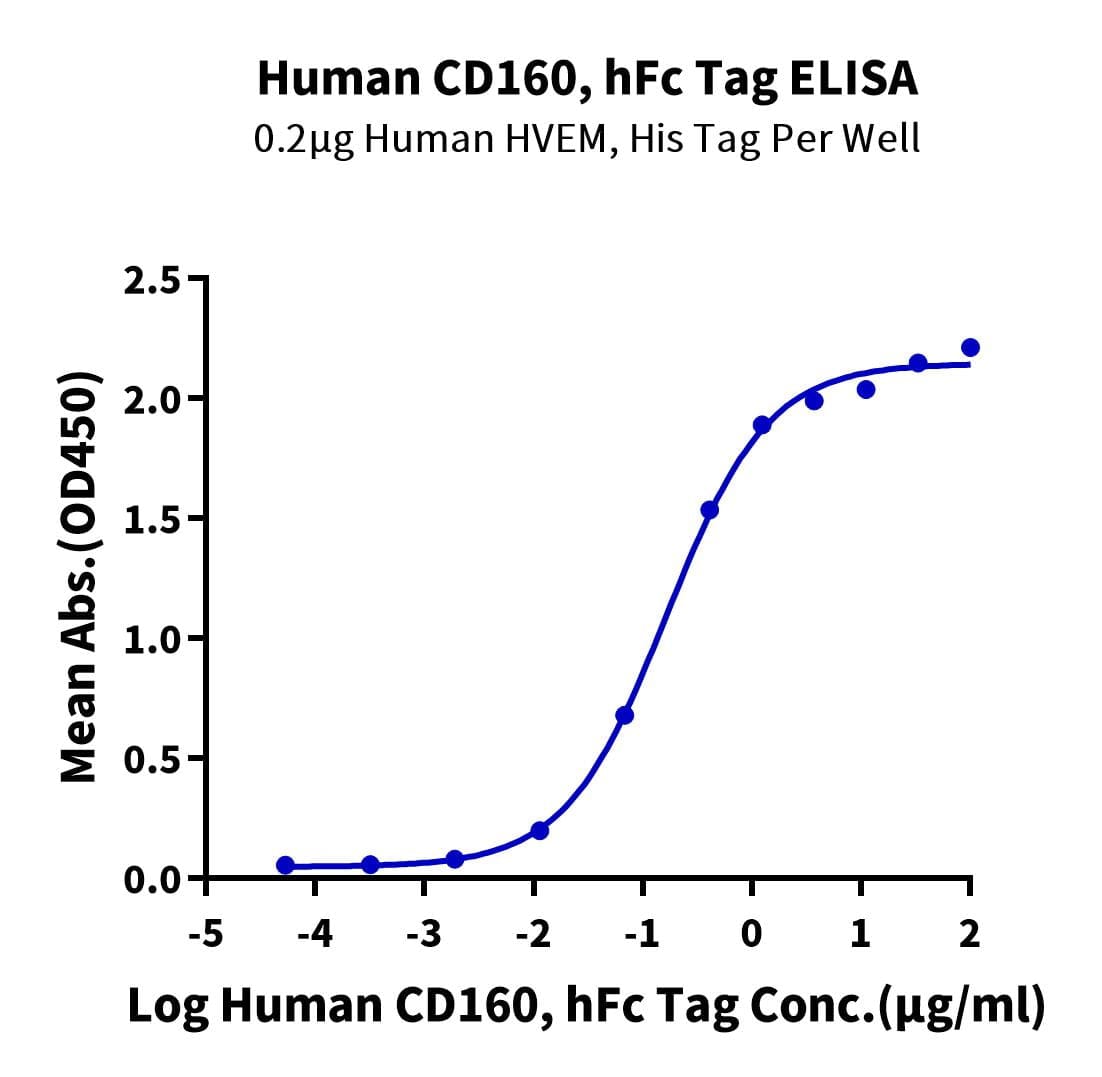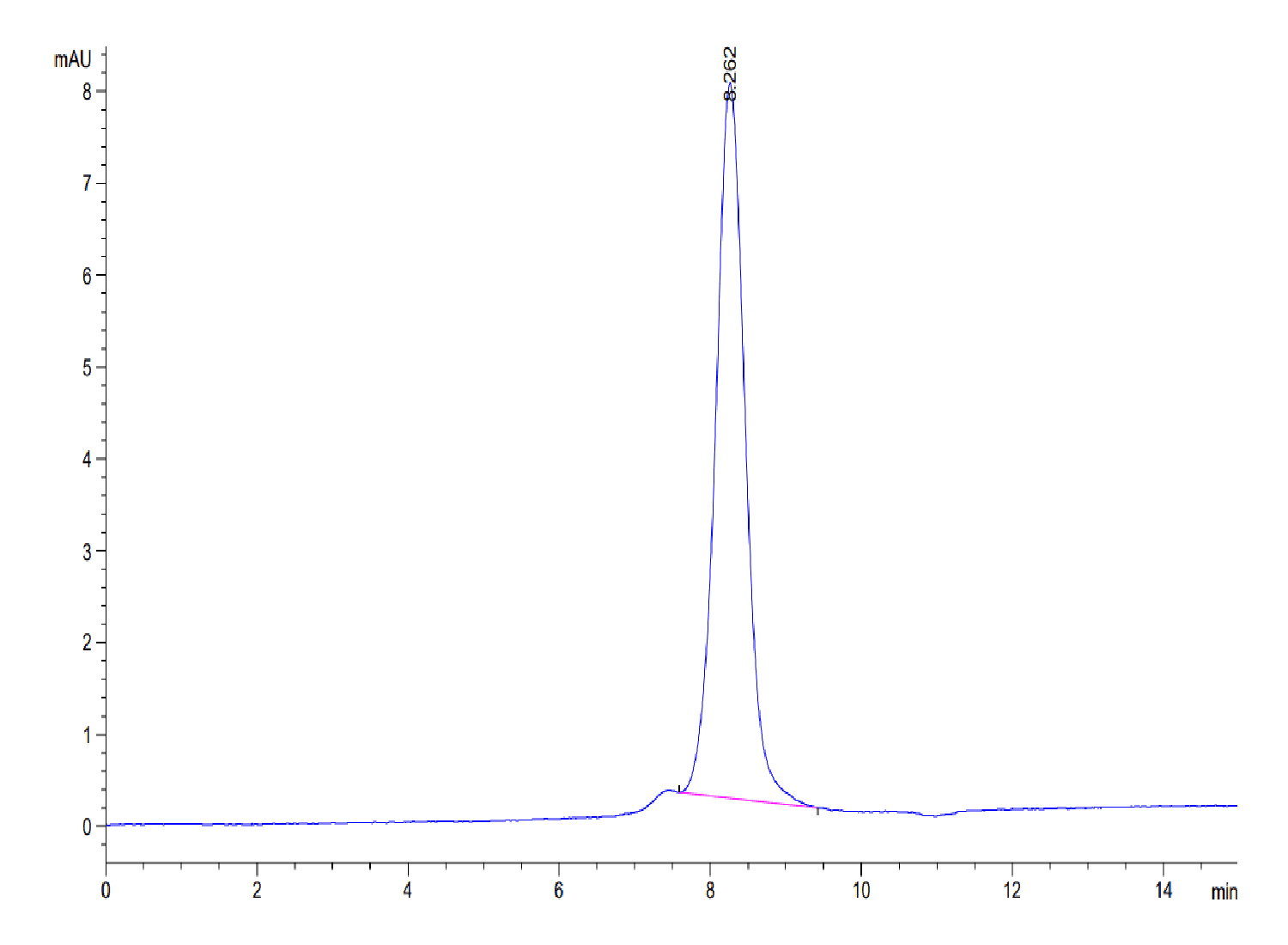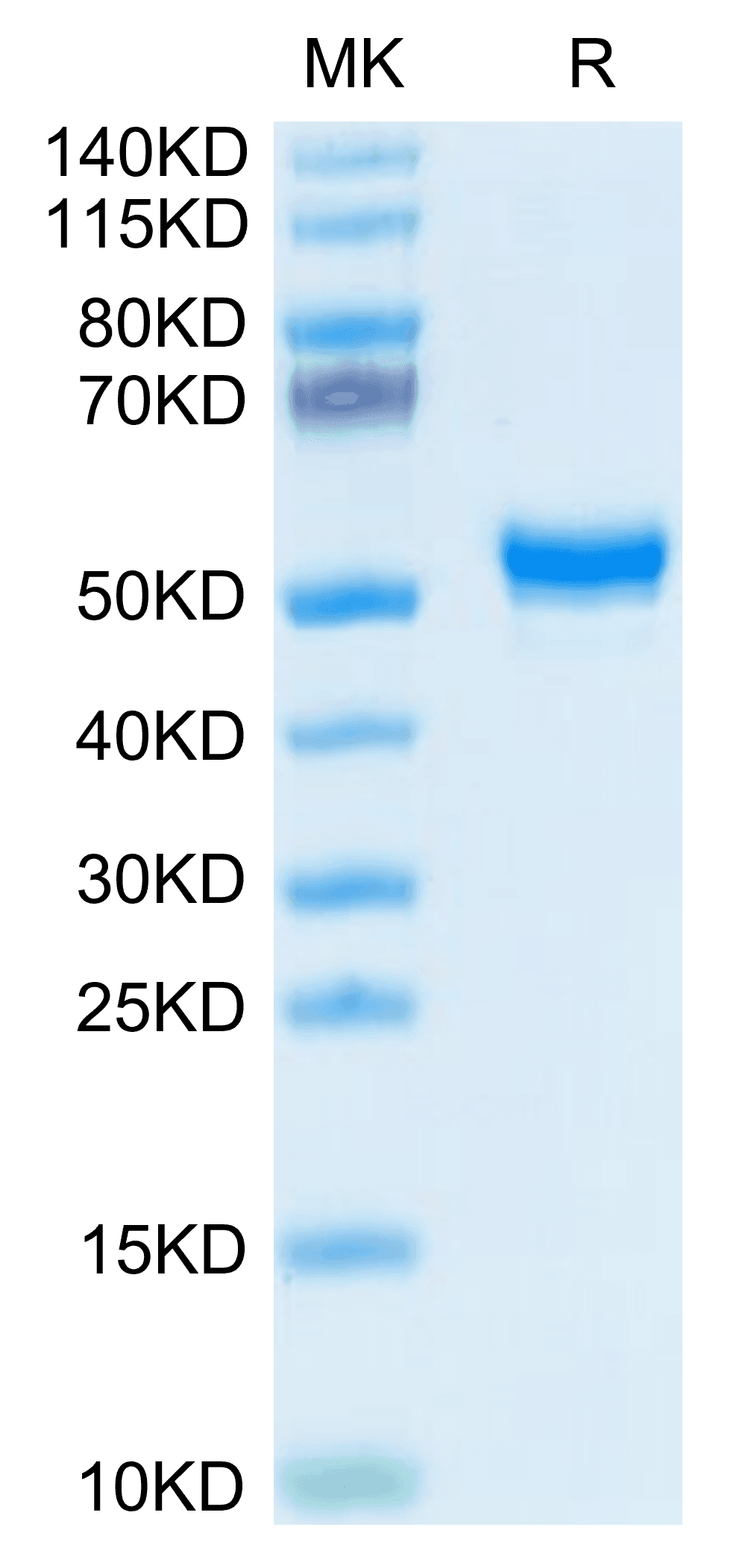| Weight | 1 lbs |
|---|---|
| Dimensions | 9 × 5 × 2 in |
| accession | O95971 |
| express system | HEK293 |
| product tag | C-hFc |
| purity | > 95% as determined by Tris-Bis PAGE;> 95% as determined by HPLC |
| background | CD160 (also Natural killer cell receptor BY55) is a 27 ‑ 30 kDa member of the Ig superfamily. In human, it is expressed principally on nonmyeloid hematopoietic cells. CD160 antigenis a receptor on immune cells capable to deliver stimulatory or inhibitory signals that regulate cell activation and differentiation. Exists as a GPI-anchored and as a transmembrane form, each likely initiating distinct signaling pathways via phosphoinositol 3-kinase in activated NK cells and via LCK and CD247/CD3 zeta chain in activated T cells. |
| molecular weight | The protein has a predicted MW of 41.3 kDa. Due to glycosylation, the protein migrates to 50-60 kDa based on Tris-Bis PAGE result. |
| available size | 100 µg, 500 µg |
| endotoxin | Less than 1EU per μg by the LAL method. |
Human CD160 Protein 3840
$240.00 – $800.00
Summary
- Expression: HEK293
- Functional: Yes (ELISA)
- Amino Acid Range: Gly25-Leu158
Human CD160 Protein 3840
| protein |
|---|
| Size and concentration 100, 500µg and lyophilized |
| Form Lyophilized |
| Storage Instructions Valid for 12 months from date of receipt when stored at -80°C. Recommend to aliquot the protein into smaller quantities for optimal storage. Please minimize freeze-thaw cycles. |
| Storage buffer Shipped at ambient temperature. |
| Purity > 95% as determined by Tris-Bis PAGE |
| target relevance |
|---|
| CD160 (also Natural killer cell receptor BY55) is a 27 - 30 kDa member of the Ig superfamily. In human, it is expressed principally on nonmyeloid hematopoietic cells. CD160 antigenis a receptor on immune cells capable to deliver stimulatory or inhibitory signals that regulate cell activation and differentiation. Exists as a GPI-anchored and as a transmembrane form, each likely initiating distinct signaling pathways via phosphoinositol 3-kinase in activated NK cells and via LCK and CD247/CD3 zeta chain in activated T cells. |
| Protein names CD160 antigen (Natural killer cell receptor BY55) (CD antigen CD160) [Cleaved into: CD160 antigen, soluble form] |
| Gene names CD160,CD160 BY55 |
| Mass 9606Da |
| Function [CD160 antigen]: Receptor on immune cells capable to deliver stimulatory or inhibitory signals that regulate cell activation and differentiation. Exists as a GPI-anchored and as a transmembrane form, each likely initiating distinct signaling pathways via phosphoinositol 3-kinase in activated NK cells and via LCK and CD247/CD3 zeta chain in activated T cells (PubMed:11978774, PubMed:17307798, PubMed:19109136). Receptor for both classical and non-classical MHC class I molecules (PubMed:12486241, PubMed:9973372). In the context of acute viral infection, recognizes HLA-C and triggers NK cell cytotoxic activity, likely playing a role in anti-viral innate immune response (PubMed:12486241). On CD8+ T cells, binds HLA-A2-B2M in complex with a viral peptide and provides a costimulatory signal to activated/memory T cells (PubMed:9973372). Upon persistent antigen stimulation, such as occurs during chronic viral infection, may progressively inhibit TCR signaling in memory CD8+ T cells, contributing to T cell exhaustion (PubMed:25255144). On endothelial cells, recognizes HLA-G and controls angiogenesis in immune privileged sites (PubMed:16809620). Receptor or ligand for TNF superfamily member TNFRSF14, participating in bidirectional cell-cell contact signaling between antigen presenting cells and lymphocytes. Upon ligation of TNFRSF14, provides stimulatory signal to NK cells enhancing IFNG production and anti-tumor immune response (By similarity). On activated CD4+ T cells, interacts with TNFRSF14 and down-regulates CD28 costimulatory signaling, restricting memory and alloantigen-specific immune response (PubMed:18193050). In the context of bacterial infection, acts as a ligand for TNFRSF14 on epithelial cells, triggering the production of antimicrobial proteins and pro-inflammatory cytokines (By similarity).; [CD160 antigen, soluble form]: The soluble GPI-cleaved form, usually released by activated lymphocytes, might play an immune regulatory role by limiting lymphocyte effector functions. |
| Subellular location [CD160 antigen]: Cell membrane ; Lipid-anchor, GPI-anchor .; [CD160 antigen, soluble form]: Secreted. Note=Released from the cell membrane by GPI cleavage. |
| Tissues Expression is restricted to functional NK and cytotoxic T lymphocytes. Expressed in viral-specific effector memory and terminally differentiated effector memory CD8+ T cells. Expressed in memory and activated CD4+ T cell subsets (at protein level) (PubMed:11978774, PubMed:18193050, PubMed:25255144, PubMed:9743336). Expressed at high levels in intraepithelial lymphocytes (at protein level) (PubMed:9743336). Expressed in both alpha-beta and gamma-delta CD8+ T cell subsets (at protein level) (PubMed:11978774, PubMed:18193050, PubMed:9743336). Expressed in umbilical vein endothelial cells (at protein level) (PubMed:16809620). Expressed in monocytes and at lower levels in B cells (PubMed:23761635). Isoform 3: Expressed exclusively in activated NK cells (at protein level) (PubMed:19109136). |
| Structure Homomultimer; disulfide-linked (Probable). Interacts with HLA-G (PubMed:16809620). Interacts with HLA-A2-B2M in complex with an HIV-derived peptide (PubMed:9973372). Interacts with TNFRSF14 (via cysteine-rich domain 1); this interaction is direct (PubMed:18193050). Interacts with LCK and CD247/CD3 zeta chain (PubMed:11978774). |
| Target Relevance information above includes information from UniProt accession: O95971 |
| The UniProt Consortium |
Data
Publications
Publications
| pmid | title | authors | citation |
|---|---|---|---|
| We haven't added any publications to our database yet. | |||
Protocols
| relevant to this product |
|---|
Documents
| # | ||
|---|---|---|
| Please enter your product and batch number here to retrieve product datasheet, SDS, and QC information. | ||

















